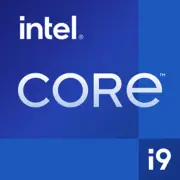Intel Core i9-10900F

Intel Core i9-10900F: Is It Worth Buying in 2025? A Complete Review
April 2025
Despite the release of new generations of processors, the Intel Core i9-10900F remains a popular choice for budget high-performance builds. Let's explore why this 10-core chip is still relevant and who it is suitable for.
1. Key Specifications: An Oldie with Strong Potential
Architecture and Process
The processor is built on the Comet Lake architecture (14 nm), which debuted back in 2020. Despite its "age," 10 cores and 20 threads (base frequency – 2.8 GHz, max Turbo Boost – 5.2 GHz) provide high multi-threaded performance.
Key Features:
- 20 MB of L3 cache – reduces delays when processing data.
- 65 W TDP – low power consumption for its class.
- Support for Hyper-Threading – 20 logical cores for parallel tasks.
Performance:
- Geekbench 6: 1676 (single-core), 8390 (multi-core).
- In Cinebench R23 tests: ~1350 (Single Core), ~13500 (Multi Core).
A practical example: In 4K video editing in DaVinci Resolve, the i9-10900F performs on par with the Ryzen 9 5900X but lags behind the newer Core i5-14600K in single-threaded tasks due to outdated IPC (instructions per clock).
2. Compatible Motherboards: LGA 1200 Socket and Nuances
Chipsets for the i9-10900F:
- Z490/Z590 – for memory overclocking and maximum performance (although the processor itself is not overclockable).
- B460/B560/H570 – budget options with support for DDR4-2933 MHz.
Recommendations for 2025:
- ASUS ROG Strix Z590-F ($220–250) – the optimal choice for PCIe 4.0 (activated with the 11th generation Intel, but for i9-10900F it operates at PCIe 3.0).
- MSI B560M Pro-VDH ($130–150) – for compact builds.
Important: LGA 1200 motherboards are gradually being phased out, but remain available on the secondary market. When purchasing a new one, check compatibility with Comet Lake via the CPU Support list.
3. Memory Support: Only DDR4
The i9-10900F works exclusively with DDR4:
- Officially supports up to DDR4-2933 MHz.
- In practice, with Z490/Z590 motherboards, it can be overclocked to DDR4-3600 MHz (depending on the memory quality).
Recommendations:
- For gaming: 2x16 GB DDR4-3200 CL16 (e.g., Kingston Fury Renegade, $90–110).
- For work tasks: 4x8 GB DDR4-3600 CL18 (capacity is important for rendering).
Note: DDR5 is not supported — this is a major disadvantage for future upgrades.
4. Power Supply: Power Calculation
With a TDP of 65 W, the processor modestly impacts power consumption, but the graphics card must be considered:
- RTX 4070 (200 W) + i9-10900F: minimum PSU – 550 W (recommended 650 W for headroom).
- RTX 4060 (115 W): 500 W is sufficient.
Recommended Models:
- Corsair RM650x (80+ Gold, $110–130) – quiet and reliable.
- be quiet! Pure Power 12 M 600W ($90–100) – a budget option.
Experience: In builds with i9-10900F and RTX 3080 (320 W), a 750 W PSU does not show drops even under peak loads.
5. Pros and Cons
Pros:
- High multi-threaded performance for $250–300 (new, leftovers from warehouses).
- Low heat – even the BOX cooler handles it under load.
- Compatibility with affordable DDR4.
Cons:
- No PCIe 4.0/5.0 – discrete GPUs and NVMe SSDs won't unleash their full potential.
- 14 nm vs. 7 nm competition – higher power consumption under peak loads (up to 150 W).
- No integrated graphics – a discrete graphics card is required.
6. Use Cases
Gaming
- In Full HD with RTX 4060: stable 100+ FPS in Cyberpunk 2077 (without ray tracing).
- At 1440p, the processor won't bottleneck a GPU like the RTX 4070.
Work Tasks
- Video editing: 4K rendering in Premiere Pro is 20-30% faster than with the Ryzen 7 5800X.
- 3D modeling: Blender and Maya utilize all 20 threads.
Multimedia
- Streaming (OBS + gaming) without lag thanks to the 10 cores.
7. Comparison with Competitors
- AMD Ryzen 7 7700X ($320):
+ Supports DDR5 and PCIe 5.0.
– More expensive by 20–25%.
- Intel Core i5-14600K ($280):
+ Better IPC and supports PCIe 5.0.
– Only 14 cores (6 P-cores + 8 E-cores).
- Ryzen 9 5900X (used, $250):
+ 12 cores, 7 nm.
– Lacks new technologies like AVX-512.
Conclusion: The i9-10900F is a price winner among new processors but falls short in terms of upgrade prospects.
8. Assembly Tips
- Cooling:
— The BOX cooler is sufficient for office tasks, but for gaming/rendering, get a tower cooler (DeepCool AK620, $60) or AIO (NZXT Kraken X53, $130).
- Case:
— At least 2 intake fans. Example – Fractal Design Meshify C ($90).
- Storage:
— Samsung 980 Pro (PCIe 4.0, but the processor will limit speed to 3.0).
9. Conclusion: Who Should Consider the i9-10900F in 2025?
This processor is worth choosing if:
- You need a powerful PC for editing or streaming but are on a budget.
- You are upgrading an old LGA 1200 system.
- You do not plan to switch to DDR5 and PCIe 5.0 in the next 2–3 years.
Target Audience:
- Content creators, streamers, gamers with a GPU level of RTX 4060/4070.
- Office workstations with demanding software (AutoCAD, Photoshop).
Alternative: If your budget allows, it’s better to opt for the Ryzen 7 7700X or Core i5-14600K for future upgrade potential.
In 2025, the Intel Core i9-10900F is a "workhorse" for those who value a balance of price and multi-thread performance but are willing to cope with outdated technologies.
Basic
CPU Specifications
Memory Specifications
Miscellaneous
Benchmarks
Compared to Other CPU
Share in social media
Or Link To Us
<a href="https://cputronic.com/en/cpu/intel-core-i9-10900f" target="_blank">Intel Core i9-10900F</a>